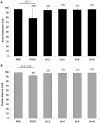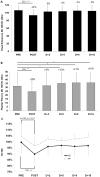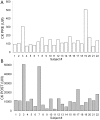Neuromuscular consequences of an extreme mountain ultra-marathon
- PMID: 21364944
- PMCID: PMC3043077
- DOI: 10.1371/journal.pone.0017059
Neuromuscular consequences of an extreme mountain ultra-marathon
Abstract
We investigated the physiological consequences of one of the most extreme exercises realized by humans in race conditions: a 166-km mountain ultra-marathon (MUM) with 9500 m of positive and negative elevation change. For this purpose, (i) the fatigue induced by the MUM and (ii) the recovery processes over two weeks were assessed. Evaluation of neuromuscular function (NMF) and blood markers of muscle damage and inflammation were performed before and immediately following (n = 22), and 2, 5, 9 and 16 days after the MUM (n = 11) in experienced ultra-marathon runners. Large maximal voluntary contraction decreases occurred after MUM (-35% [95% CI: -28 to -42%] and -39% [95% CI: -32 to -46%] for KE and PF, respectively), with alteration of maximal voluntary activation, mainly for KE (-19% [95% CI: -7 to -32%]). Significant modifications in markers of muscle damage and inflammation were observed after the MUM as suggested by the large changes in creatine kinase (from 144 ± 94 to 13,633 ± 12,626 UI L(-1)), myoglobin (from 32 ± 22 to 1,432 ± 1,209 µg L(-1)), and C-Reactive Protein (from <2.0 to 37.7 ± 26.5 mg L(-1)). Moderate to large reductions in maximal compound muscle action potential amplitude, high-frequency doublet force, and low frequency fatigue (index of excitation-contraction coupling alteration) were also observed for both muscle groups. Sixteen days after MUM, NMF had returned to initial values, with most of the recovery process occurring within 9 days of the race. These findings suggest that the large alterations in NMF after an ultra-marathon race are multi-factorial, including failure of excitation-contraction coupling, which has never been described after prolonged running. It is also concluded that as early as two weeks after such an extreme running exercise, maximal force capacities have returned to baseline.
Conflict of interest statement
Figures






References
-
- Hoffman MD, Ong JC, Wang G. Historical analysis of participation in 161-km ultramarathons in North America. Int J History Sport. 2010;27:1877–1891. - PubMed
-
- Martin V, Kerhervé H, Messonnier LA, Banfi JC, Geyssant A, et al. Central and peripheral contributions to neuromuscular fatigue induced by a 24-h treadmill run. J Appl Physiol. 2010;108:1224–1233. - PubMed
-
- Pearson H. Physiology: freaks of nature? Nature. 2006;444:1000–1001. - PubMed
-
- Enoka RM, Stuart DG. Neurobiology of muscle fatigue. J Appl Physiol. 1992;72:1631–1648. - PubMed
-
- Millet GY, Lepers R. Alterations of neuromuscular function after prolonged running, cycling and skiing exercises. Sports Med. 2004;34:105–116. - PubMed
Publication types
MeSH terms
LinkOut - more resources
Full Text Sources
Medical
Research Materials

